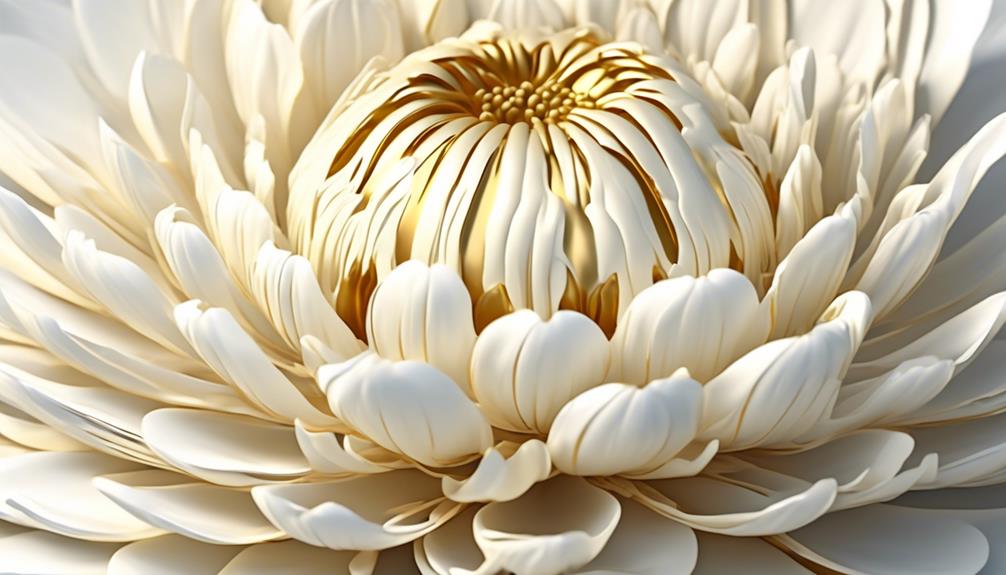Imagine a garden filled with vibrant blooms, each representing a different aspect of life. Among them, a white chrysanthemum stands tall, its delicate petals whispering stories of resilience and truth.
Just as this flower symbolizes the seeker of truth, Mary Lynn Bracht's novel, 'White Chrysanthemum: The Truth-Seeker's Bloom,' uncovers the harrowing experiences of Korean comfort women during World War II.
With its heart-wrenching narrative and powerful themes, this book invites you into a world where the past intertwines with the present, leaving you yearning for answers and seeking a deeper understanding of the human spirit.
Historical Significance
The historical significance of 'White Chrysanthemum' lies in its unflinching portrayal of the overlooked experiences of Korean women forced into sexual slavery during World War II, shedding light on the human cost of conflict and the enduring repercussions of historical injustices.
Through its powerful narrative, the novel exposes the atrocities committed by the Imperial Japanese and provides a compelling account of the comfort women issue under Japanese occupation. By delving into the lives of these women, 'White Chrysanthemum' reveals the deep impact of war, sacrifice, and love.
It contributes to the ongoing discourse on wartime atrocities, serving as a significant testimony to the resilience and suffering of those affected by historical injustices. This exploration of the lasting historical impact of conflicts, particularly on women, emphasizes the need to acknowledge and address the enduring consequences of war and trauma.
Story and Origins
In 'White Chrysanthemum', Mary Lynn Bracht takes readers on a poignant journey through the story and origins of Hana, a haenyeo, and her sister Emi, as they navigate the tumultuous landscape of World War II in Korea.
This historical fiction novel tells us about the experiences of Korean women during this dark period in history. Bracht, who's of Korean descent, sheds light on the horrifying reality faced by these women, particularly those forced into sexual slavery by the Japanese occupation.
The book has received high ratings and positive reviews, with readers describing it as powerful and well-researched. 'White Chrysanthemum' has resonated with readers around the world, providing a heartbreaking and compelling portrayal of the sacrifices made and the resilience of the women who survived.
Flower of Grief
As the story of Hana and Emi unfolds, readers are transported into the heart-wrenching reality of the 'Flower of Grief', a powerful depiction of the experiences endured by Korean comfort women during World War II.
Mary Lynn Bracht's novel, 'White Chrysanthemum', provides a compelling and emotional reading experience through alternating narratives of Hana, a haenyeo turned comfort woman, and her sister Emi, seeking forgiveness in 2011.
By shedding light on the historical events of sexual slavery during the Japanese occupation, Bracht portrays the harrowing experiences of the protagonists.
'White Chrysanthemum' has been praised for its well-researched and beautifully written tribute to Korean women, giving a voice to survivors of this dark period in history.
The novel is described as heartbreaking, powerful, and deserving of high praise for its portrayal of a difficult and often overlooked part of history.
Symbolism of Life's Transience
Embracing the fleeting nature of life, the symbolism of the chrysanthemum's transience reminds us to cherish each passing moment. Just as the delicate petals of the chrysanthemum fall, so too do the moments and experiences of our lives pass by.
The chrysanthemum's transience serves as a powerful reminder of the impermanence of all things. By embracing this symbolism, we're encouraged to appreciate the beauty in every fleeting moment.
The cycle of the chrysanthemum mirrors the ephemerality of life, reminding us to savor each passing season. In a world that often feels chaotic and uncertain, the chrysanthemum's transience teaches us the importance of living in the present and finding joy in the fleeting beauty that surrounds us.
Pruning Techniques
To effectively prune your plants and promote healthy growth, use sharp, clean tools to make precise cuts at a 45-degree angle during the dormant season. This will encourage proper healing and minimize damage.
Remember to regularly remove dead, diseased, or crossing branches to improve air circulation and reduce the risk of pests and diseases.
It's important to prune to maintain the natural shape of the plant and avoid cutting more than one-third of the plant at a time to prevent stress and shock.
Each plant has specific needs, so consider these when pruning. For example, flowering shrubs may require selective pruning to encourage blooming.
Best Occasions for Gifting
When considering the perfect occasion to gift White Chrysanthemum, honor the strength and resilience of women on Mother's Day or International Women's Day. These beautiful flowers symbolize the qualities that women embody and make them a meaningful gift to show appreciation and admiration. Additionally, White Chrysanthemum can be a fitting choice for anniversaries or memorial days, as they represent truth, loyal love, and remembrance of historical events. For book lovers, gifting White Chrysanthemum during literary events or book club gatherings can evoke the emotions and experiences depicted in the novel. Furthermore, these flowers are also suitable for historical or cultural themed events, as they hold significant historical and cultural symbolism. Lastly, presenting White Chrysanthemum during times of forgiveness, reconciliation, or to express empathy and understanding can be a touching gesture in personal relationships.
| Occasion | Reason |
|---|---|
| Mother's Day | Honoring the strength and resilience of women |
| International Women's Day | Celebrating women's achievements and contributions |
| Anniversaries | Symbolizing truth, loyal love, and remembrance |
| Memorial Days | Commemorating historical events and paying respects |
| Literary events | Reflecting the emotions and experiences in books |
| Historical/Cultural themed events | Representing historical and cultural significance |
| Forgiveness/Reconciliation | Expressing empathy and understanding |
Concluding Thought
As you reflect on the profound impact and symbolism of 'White Chrysanthemum', you can't help but be moved by the poignant exploration of war, sacrifice, love, and forgiveness.
Mary Lynn Bracht's powerful and well-researched novel sheds light on the horrifying experiences of Korean women during World War II. The alternating narratives of Hana and Emi provide a compelling and emotional reading experience, delving deep into the themes of war, sacrifice, love, and forgiveness.
Bracht's beautifully written tribute to Korean women gives voice to the survivors of a dark period in history. With a high rating of 4.40 out of 5 based on 20,402 reviews, the novel resonates with readers.
The chrysanthemum flower, rich in symbolism, serves as a fitting metaphor for the truth, loyalty, and revelation that unfold throughout the novel.
'White Chrysanthemum' offers a thought-provoking and resonant exploration of the human spirit in the face of adversity.
Frequently Asked Questions
What Does the White Chrysanthemum Symbolize?
The white chrysanthemum symbolizes truth and loyal love. It speaks to you, revealing the essence of honesty and unwavering devotion. It is a beacon of light, guiding you towards the path of authenticity.
What Is the Book White Chrysanthemum About?
'White Chrysanthemum' is a powerful historical fiction novel set in Korea during World War II. It follows the experiences of Hana and Emi as they face the atrocities of Japanese occupation and shed light on the experiences of Korean women forced into sexual slavery.
What Does the White Chrysanthemum Flower Mean in Japan?
In Japan, the white chrysanthemum symbolizes truth and loyal love. It represents the unfolding of truth and is associated with the Imperial House. Its bright white flowers offer a refreshing and sweet taste.
What Does White Chrysanthemum Mean in Korean?
In Korean culture, the white chrysanthemum symbolizes honesty, purity, and noble character. It is used in funerals and to pay respects to ancestors, representing grief and sorrow, while also signifying the beauty and transience of life.





